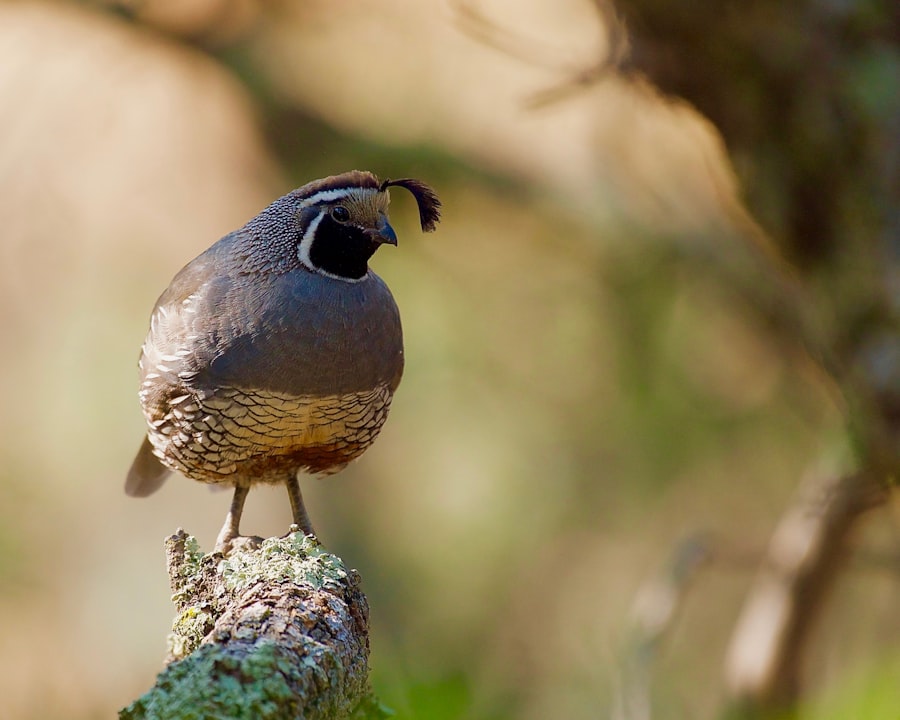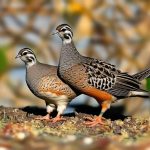Coturnix and Button Quails are both popular choices for backyard poultry enthusiasts and are often kept together due to their small size and similar care requirements. Coturnix Quails, also known as Japanese Quails, are the most commonly kept quail species for egg and meat production. They are known for their hardiness, adaptability, and high egg production, making them a popular choice for small-scale poultry farming. On the other hand, Button Quails, also known as Chinese Painted Quails, are smaller in size and are often kept as pets or for their unique and colorful plumage. While they are not as commonly kept for egg or meat production as Coturnix Quails, they are still popular among bird enthusiasts for their charming personalities and low maintenance requirements.
Both Coturnix and Button Quails are ground-dwelling birds that are native to Asia and have been domesticated for centuries. They are known for their social nature and can be kept in small flocks, making them an ideal choice for those with limited space. These quails are also relatively quiet compared to other poultry species, making them suitable for urban or suburban settings where noise may be a concern. Additionally, both Coturnix and Button Quails are prolific layers, with Coturnix Quails laying up to 300 eggs per year and Button Quails laying around 100 eggs per year. With their small size, gentle nature, and low maintenance requirements, Coturnix and Button Quails are excellent choices for beginners and experienced poultry keepers alike.
Key Takeaways
- Coturnix and Button quails are small, ground-dwelling birds that are popular for their small size and low maintenance.
- Coturnix quails are larger and more commonly kept for their eggs and meat, while Button quails are smaller and often kept for their unique appearance and behavior.
- It is important to consider the different social and environmental needs of Coturnix and Button quails before keeping them together in the same enclosure.
- Both Coturnix and Button quails require a secure and spacious enclosure with proper ventilation, substrate, and hiding spots to thrive.
- A balanced diet of commercial quail feed, fresh greens, and occasional treats like mealworms or fruits is essential for the health and well-being of Coturnix and Button quails.
Understanding the Differences Between Coturnix and Button Quails
While Coturnix and Button Quails share many similarities, there are some key differences between the two species that should be taken into consideration when keeping them together. One of the most noticeable differences is their size, with Coturnix Quails being larger and more robust compared to the smaller and more delicate Button Quails. This size difference can impact their housing requirements, feeding needs, and even their compatibility with other bird species. Additionally, Coturnix Quails are known for their high egg production and are often kept for commercial purposes, while Button Quails are primarily kept for ornamental purposes due to their unique and colorful plumage.
In terms of behavior, Coturnix Quails are generally more social and can be kept in larger flocks, while Button Quails are known to be more territorial and may exhibit aggressive behavior towards other quail species if not provided with enough space and resources. This territorial behavior can also impact their compatibility with other bird species, as Button Quails may not tolerate the presence of other ground-dwelling birds in their environment. Understanding these differences is crucial for successfully keeping Coturnix and Button Quails together, as it will help ensure that their individual needs are met and that they can coexist harmoniously in a shared living space.
Considerations for Keeping Coturnix and Button Quails Together
When considering keeping Coturnix and Button Quails together, there are several important factors to take into account to ensure the well-being of both species. One of the most critical considerations is providing adequate space for both quail species to thrive. While Coturnix Quails can be kept in larger flocks due to their social nature, Button Quails require more space per bird to accommodate their territorial behavior. It is recommended to provide at least 1 square foot of space per Coturnix Quail and 2 square feet of space per Button Quail to prevent overcrowding and reduce the risk of aggression between the two species.
Another consideration is providing suitable hiding spots and visual barriers within the shared living space to allow both quail species to establish their territories and avoid potential conflicts. This can be achieved by incorporating natural vegetation, such as shrubs or tall grasses, as well as artificial structures like wooden shelters or PVC pipes to create separate areas for each quail species to retreat to when needed. Additionally, providing multiple feeding and watering stations can help minimize competition for resources and reduce the likelihood of aggressive behavior between Coturnix and Button Quails. By carefully considering these factors and providing a well-designed living environment, it is possible to successfully keep both quail species together while ensuring their individual needs are met.
Housing Requirements for Coturnix and Button Quails
When it comes to housing Coturnix and Button Quails together, it is essential to provide a suitable living environment that meets the specific needs of each quail species. Both Coturnix and Button Quails are ground-dwelling birds that require a secure and predator-proof enclosure to protect them from potential threats such as predators or extreme weather conditions. The housing should also provide adequate ventilation to prevent moisture buildup and maintain good air quality within the enclosure. Additionally, it is important to consider the flooring material, as both quail species are prone to leg injuries if housed on wire flooring. Providing a solid or mesh flooring covered with a layer of soft bedding material, such as straw or wood shavings, can help prevent foot injuries and promote good foot health.
In terms of nesting areas, Coturnix Quails will require suitable nesting boxes or shelters where they can lay their eggs in privacy, while Button Quails may prefer more secluded nesting spots due to their territorial nature. Providing multiple nesting options within the enclosure can help accommodate the individual preferences of each quail species and reduce competition for nesting sites. It is also important to regularly clean and maintain the nesting areas to ensure a hygienic environment and prevent the buildup of bacteria or parasites that could negatively impact the health of the quails. By carefully considering these housing requirements and providing a well-designed living space, it is possible to create a safe and comfortable environment for both Coturnix and Button Quails to thrive.
Feeding and Diet for Coturnix and Button Quails
Proper nutrition is essential for the health and well-being of both Coturnix and Button Quails, and providing a balanced diet is crucial for maintaining their overall health and productivity. Both quail species have similar dietary requirements, with a diet consisting of high-quality commercial quail feed supplemented with fresh fruits, vegetables, and protein sources such as mealworms or crickets. It is important to provide access to clean water at all times, as quails have high water requirements, especially during egg production.
When feeding Coturnix and Button Quails together, it is important to consider their individual feeding behaviors and preferences. Coturnix Quails are known to be more aggressive eaters compared to Button Quails and may outcompete them for food if not provided with enough feeding stations. To prevent this, it is recommended to provide multiple feeding stations within the enclosure to ensure that all quails have equal access to food. Additionally, offering a variety of food options can help meet the specific nutritional needs of each quail species and prevent boredom or selective feeding behaviors.
It is also important to monitor the body condition of both quail species regularly to ensure they are receiving adequate nutrition. Adjusting the feeding regimen based on their individual needs, such as increasing protein levels during periods of high egg production or providing additional calcium sources for laying hens, can help support their overall health and productivity. By carefully considering their dietary requirements and providing a well-balanced diet, it is possible to ensure that both Coturnix and Button Quails receive the nutrition they need to thrive in a shared living environment.
Potential Health Concerns and Compatibility Issues

When keeping Coturnix and Button Quails together, it is important to be aware of potential health concerns and compatibility issues that may arise between the two quail species. One common health concern for both quail species is coccidiosis, a parasitic disease that can affect the digestive system and cause diarrhea, weight loss, and even death if left untreated. Providing a clean living environment, practicing good hygiene, and administering preventive measures such as medicated feed or regular deworming can help reduce the risk of coccidiosis in both Coturnix and Button Quails.
Another potential health concern is respiratory infections, which can be caused by poor ventilation, high humidity levels, or exposure to drafts within the enclosure. Monitoring the air quality within the housing area and providing adequate ventilation can help prevent respiratory issues in both quail species. Additionally, it is important to quarantine any new birds before introducing them to an existing flock to prevent the spread of infectious diseases.
In terms of compatibility issues, it is important to monitor the behavior of both quail species closely to identify any signs of aggression or territorial disputes. Providing adequate space, hiding spots, and visual barriers within the enclosure can help minimize potential conflicts between Coturnix and Button Quails. It is also important to consider the compatibility of other bird species that may share the same living space, as some ground-dwelling birds may not coexist peacefully with either Coturnix or Button Quails due to territorial behavior or competition for resources.
Tips for Successfully Keeping Coturnix and Button Quails Together
Successfully keeping Coturnix and Button Quails together requires careful planning, attention to detail, and proactive management practices to ensure the well-being of both quail species. Providing adequate space per bird, suitable hiding spots, multiple feeding stations, and clean nesting areas can help create a harmonious living environment for both quail species. It is also important to monitor their behavior closely and intervene if any signs of aggression or territorial disputes arise.
Regular health checks, preventive measures against common diseases such as coccidiosis, respiratory infections, or external parasites can help maintain the overall health of both Coturnix and Button Quails. Additionally, providing a well-balanced diet that meets their specific nutritional needs can support their overall health and productivity in a shared living environment.
By carefully considering these tips and implementing proactive management practices, it is possible to successfully keep Coturnix and Button Quails together while ensuring that their individual needs are met. With proper care, attention, and a well-designed living environment, both quail species can thrive in a shared living space while providing joy and entertainment for poultry enthusiasts and bird lovers alike.
If you’re considering keeping coturnix and button quails together, it’s important to understand their compatibility and care requirements. In a related article on PoultryWizard, you can learn about the essential considerations for creating a suitable living environment for quails and chickens. This article provides valuable insights into coop design, interior ideas, and insulation techniques that can help ensure the well-being of your quails and chickens. Check out the article here to discover practical tips for maintaining a harmonious and comfortable living space for your feathered friends.
FAQs
Can you keep coturnix quails with button quails?
Yes, you can keep coturnix quails with button quails as long as you provide enough space and resources for both species to thrive.
What should I consider before keeping coturnix and button quails together?
Before keeping coturnix and button quails together, consider the space requirements, feeding habits, and potential for aggression between the two species.
How much space do coturnix and button quails need when kept together?
When kept together, coturnix and button quails need at least 1 square foot of space per bird to ensure they have enough room to move around and establish their territories.
What should I feed coturnix and button quails when kept together?
When kept together, coturnix and button quails can be fed a diet of commercial quail feed, supplemented with fresh greens, fruits, and mealworms.
Are there any potential issues when keeping coturnix and button quails together?
Potential issues when keeping coturnix and button quails together include aggression, competition for resources, and the risk of crossbreeding if both species are not separated.
Meet Walter, the feathered-friend fanatic of Florida! Nestled in the sunshine state, Walter struts through life with his feathered companions, clucking his way to happiness. With a coop that’s fancier than a five-star hotel, he’s the Don Juan of the chicken world. When he’s not teaching his hens to do the cha-cha, you’ll find him in a heated debate with his prized rooster, Sir Clucks-a-Lot. Walter’s poultry passion is no yolk; he’s the sunny-side-up guy you never knew you needed in your flock of friends!







